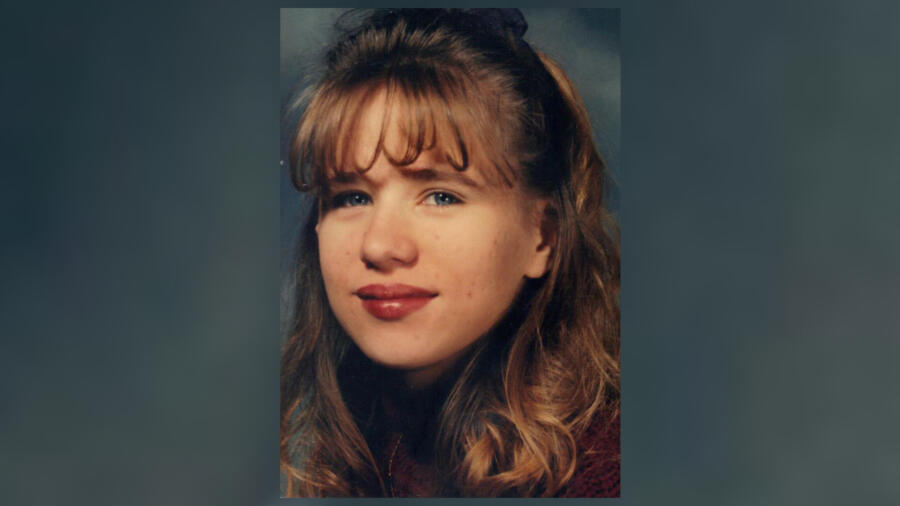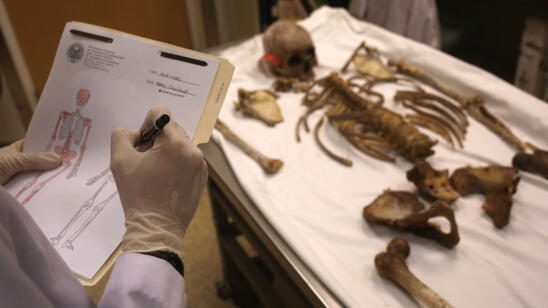In 1999, 22-year-old Sherry Leighty, a mother of three who loved animals and country music, went missing. Almost 15 years later, in 2013, Sherry’s ex-husband Aaron was speaking on the phone to his father, Kenneth Leighty, when the elder man confessed to killing his daughter-in-law, calling it an “accident.” Sherry Leighty’s remains were later discovered in Warriors Mark Township, about 100 miles east of Pittsburgh, Pennsylvania, on a property owned by Kenneth Leighty.
Leighty was convicted of third-degree murder in 2014 and sentenced to 7 to 14 years in prison after striking a plea deal, which involved him agreeing to show authorities where he buried Sherry’s body. In March 2021, he was denied parole for a second time.
Sherry Leighty’s murder was the subject of an episode of A&E’s Cold Case Files on September 3, 2021. [Watch the episode “Missing in Altoona.“]
Dr. Dennis Dirkmaat, a forensic anthropologist and chairman of the department of applied and forensic sciences at Mercyhurst University who was interviewed for the Cold Case Files episode, spoke with A&E True Crime about his work on the Sherry Leighty case and how his team helped find the missing mother’s body.
How did you become involved in the Sherry Leighty case?
I was contacted by the district attorney in Huntingdon County, Pennsylvania. They believed they had some new information on a potential cold case; that an individual might have been killed and buried on a property in the county. Some wiretaps indicated that [Kenneth Leighty] had accidentally killed [Sherry Leighty].
I asked to bring along an individual with a cadaver dog. We walked part of the property, near a hunting cabin, where the family said they had smelled something they thought was a dead animal. The police had previously conducted a search of the area and didn’t find anything. It’s possible the body had been there at some point, there were some odors and then the body was moved—what we call a secondary deposition. We didn’t get anywhere on that first day.
What happened next?
About two weeks later, the state police called and said [Leighty] had confessed and that he once again stated it was accidental. He took the police to a location where he said he dug a burial and put [his daughter-in-law] in it.
We had a team of six to eight individuals onsite the next day. This location had four or five trees pretty close to one another. We knew that with root systems, you couldn’t dig a hole [in that area] big enough to put a body. But I told police that we would test dig. So, we dug the area and showed very clearly that there was no burial there. That upset the investigators. They decided to get [Leighty] and bring him out there.
You actually had an opportunity to question Kenneth Leighty, correct?
I was off to the side when police returned with him, and they immediately called me over. I thought they wanted me to hear what he had to say. But they said, We’ll let you get it out of him.
I became the main interrogator at that point. I started asking him where he pulled the car over from the road, what he remembered seeing. He pointed in a certain direction and said he saw some rocks. I asked if he meant the small rock wall and he said that would be the location [of the body]. He explained that he was right up against it because he moved some rocks away, dug in and put some rocks on top.
You discovered a grave near the rock wall. How did you find it?
From the grove of trees that was initially identified, the rock wall extended about 300 to 400 feet. We did little test pits about every three feet to see if we could hit a burial. We dug about 25 to 30 holes. At one of the holes, a trooper thought he hit some water pipe. We were in middle of the woods. There was no indication that there had been a house or anything like that there, so it didn’t make sense.
When I got down on my hands and knees and looked in the hole, I said, ‘Those are not water pipes. That’s a tibia and fibula.’ After we found the burial, we exposed and excavated it.
One leg was visible and sort of sticking out, even though he had put rocks on top. We had the tibia, fibula and foot bones. There was a bit of a stain underneath them, which would be the decomposition.
The leg was still relatively intact and not totally devoid of soft tissue. From the positioning of the bones in that small burial, it was pretty clear that they were sort of stashed in there and some of the bones were in an unnatural position. You couldn’t put a flush individual in a hole that small in that position. It became clear that the bones were placed in there when they were in an advanced state of decomposition.
So, again, the story is there was some smell near the spot next to the grove of trees. At some point, maybe the killer had a fear of being discovered, collected the remains and then brought them up to the other location near the rock wall. We had enough evidence to back up the hypothesis that the remains had decomposed for an amount of time somewhere else.
How did you determine the remains belonged to Sherry Leighty? Although you cannot determine a cause of death, which is left to the medical examiner, did you find any indication of trauma?
We took the remains back to the laboratory to figure out exactly what we had. The skeletal inventory was pretty complete, almost everything was there. Some of the bones of the hands and feet that maybe decomposed on the surface or when he tried to pick them up, were missing. This is a common attribute of secondary burials.
After the inventory, we did what we call a biological profile, which is the age, sex, stature and ancestry of the individual. We determined this was a younger white female. At that point, we didn’t have dental records, as I recall, but they were submitted for DNA eventually.
The last part is the determination of trauma and trying to distinguish if there are broken bones and when that occurred, which bones are broken and so on. During the lifetime of an individual, bones will show signs of healing. We call those ante-mortem trauma. Those that occur right around the time of death are called peri-mortem trauma. We noted that there was damage to the skull, what we interpreted as peri-mortem trauma. The evidence of blunt force trauma to the head is what we presented in our final report.
Related Features:
How Forensic Anthropologists Reconstruct Deadly Crimes


